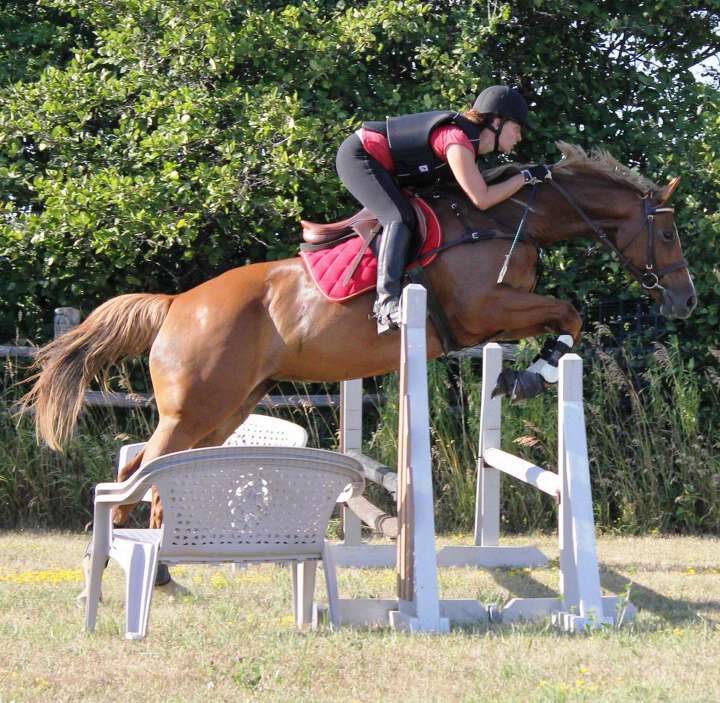Search the Site
Photo # 38: This is Caroline! (Current Freebie!)

Hi Caroline!
What a cute pair! You both look game and athletic, and I sense a good partnership at work. At first glance I was going to say that your stirrips were a bit long, but I think it just looks that way because your seat is so high out of the saddle. I'm also wondering if this saddle may not have forward enough flaps for you? If this is the case, you may find it hard to remain in perfect balance over fences, especially as the fences get bigger. You have a solid lower leg, although I would like to see more flexibility in your ankles for better shock absorbtion. I would spend some time in the dreaded two point position, really thinking "toes up" to gain more flexibility, which will allow for a deeper heel. Make sure you feel your ankles flexing with each stride, absorbing the shock of the movement.
Your center of gravity looks to be just slightly ahead of your feet here, and it is also a bit too far forward for your horse's sake. To be truly in balance with your horse, so that you are not affecting her balance in any way, you need to keep your center of gravity exactly over your horse's center of gravity. Which means you need to move your hips back a few inches from where they are in this picture. Think about pushing your seat back and squatting a bit mid air, to keep your seat closer to the middle of the saddle. This will require you to sink into your heels rather than pushing your seat upward by bracing against the stirrups. The reason this is so important (besides the fact that your center of gravity will be lower and closer to your horse's center of gravity), is that the increased angles created in your hip, knee, and ankle will make your position much stronger. And it will also increase your ability to more easily absorb the shock of jumping and landing - meaning that you will find it easier to stay out of your horse's way. Which of course will allow your horse to jump at her absolute best.
While you are thinking about pushing your hips back in the air, also think about keeping your eyes up! If necessary, exaggerate this by thinking about looking out the bottoms of your eyes in the air. This will help you to keep your back more flat as well. And once you are doing that, you will probably find that all you have to do to make your position perfect, is to let your hands drop slightly in your release so that you have more of an automatic release in the air. Your release is fine here... but having your hands so far up the neck can cause a horse to get front heavy, especially when you also have your center of gravity a bit too forward.
It sounds like I want to change a lot about your position, but I think you will find that if you push your hips back in the air, all the other changes will be minor and very easy to make! And you should then feel like you are much more solid and secure, as you will be nestled in behind your horse's shoulder, instead of up over top of it. I often tell people to imagine that their saddle is really ugly, and that they need to cover it up with their seat in the air as best they can. Not sitting, of course! But hovering over the middle of the saddle, and not up over the pommel.
Your horse looks like a real trier! She is putting in a lot of effort over this little jump! She is using her shoulders and her topline very well here, but I get a feeling that she can be a bit front heavy, which can cause a problem if she gets close to a vertical or a bigger square oxer. If she tends to get low and heavy on her forehand on the approach to jumps, then you need to do lots of homework on maintaining a good quality uphill canter! Read this article on how to package the canter stride when jumping, and this one on the adjustability exercise. Lots of half halts, rein backs, and transitions... particularly those that skip a gait like trot to halt or canter to walk, will help you to coil the spring of your horse's hind legs, to put her in a state of balance where she will be more "up in front", and therefore able to rock back on her hocks and jump more upward. Also read this article on the Rubber Band exercise, and incorporate transitions within the gaits in your everyday work. And I am talking about both flatwork and jumping days.
Good luck Caroline! Let me know if you have any questions! And please keep us all posted on your progress!






